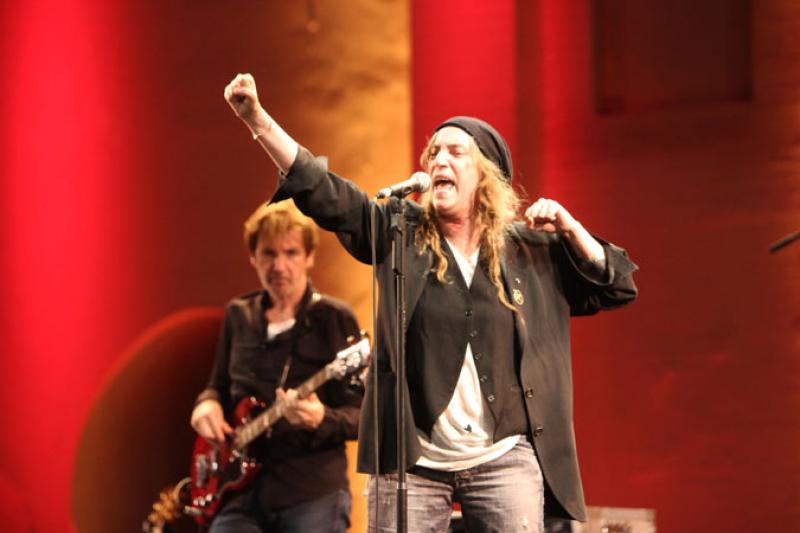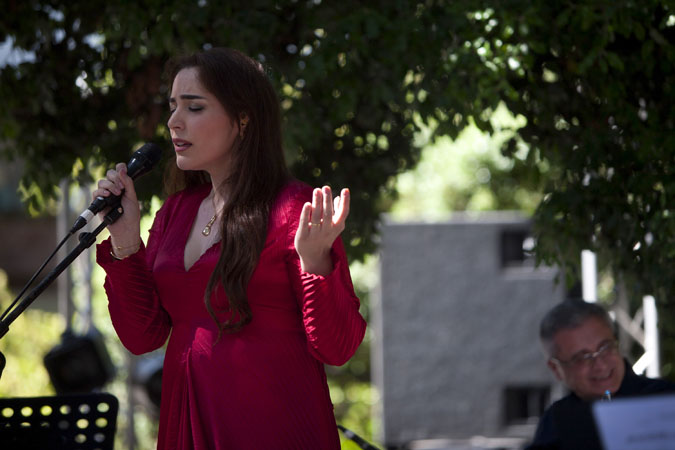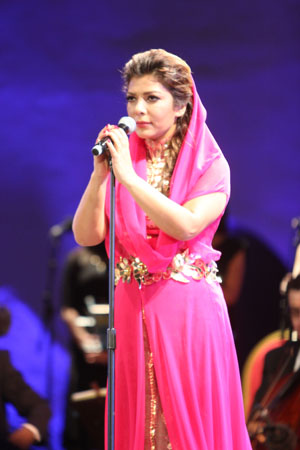theartsdesk in Fes: Patti Smith and the Sufis | reviews, news & interviews
theartsdesk in Fes: Patti Smith and the Sufis
theartsdesk in Fes: Patti Smith and the Sufis
The punk poetess and other sparkling sacred music at the Fes Festival

“The boy looked at Johnny – he was surrounded by white and blue tiles, in the medina.” Patti Smith was improvising on her classic album Horses in her first, compelling, gig in Morocco. Smith has a history of Moroccan connections: she knew the Tangier-based writer Paul Bowles and plugged into that pre-punk Beat generation, but there were some raised eyebrows as to what exactly she was doing at a “sacred” music festival.
Perhaps it would have been better to ask, What is not sacred music? Certainly most of the music of the Festival was more obviously from a spiritual tradition. Now in its 19th year, it was set up after the first Gulf War as a way to bring differing religious paths together. As an event in a Muslim country it remains a beacon of tolerance and creativity (and an inspiring contrast to the Salafists whose black flags were in the last year taking over Mali and banning music).
Paco de Lucia plugs back into flamenco roots and the fire and passion is back
But the reason Fes has established itself is that it's not just a powerful symbol in one of the Muslim world’s most sacred cities, with exchanges and discussions at the morning Fes Forum in what some have called “a spiritual Davos”, but a world-class music festival.
There were established international stars like guitarist Paco de Lucia, who in his advancing years really gives the impression that he is a total master of his instrument. Virtuosity is secondary to intellect and emotion. Just when things were threatening to get overly jazzy and cerebral, he plugs back into flamenco roots, and the fire and passion is back.
 More exciting for a music explorer are the gems you would never have come across without Fes. Outstanding this year was Abeer Nehme (pictured right) and her group, who sang Aramaic music from around the fourth century. A Christian living near Beirut, she has lived through conflict (her father was in the army and lost his leg), and she had the courage to tour Iraq in 2008; her voice has a transcendent purity. The Lebanese woman next to me said, “Finally, we have someone who could be on the level of Fairuz." Compliments don’t get much greater.
More exciting for a music explorer are the gems you would never have come across without Fes. Outstanding this year was Abeer Nehme (pictured right) and her group, who sang Aramaic music from around the fourth century. A Christian living near Beirut, she has lived through conflict (her father was in the army and lost his leg), and she had the courage to tour Iraq in 2008; her voice has a transcendent purity. The Lebanese woman next to me said, “Finally, we have someone who could be on the level of Fairuz." Compliments don’t get much greater.
It was extraordinary how her music seemed to cut through the centuries of layers built up over Christianity, the Victorians and puritans in particular. Singing in the language of Jesus, it was powerful enough that you even got some impression of the sweetness and compassion of early Christianity. It was also sufficient for me to start looking up Antioch, the Maronites, and the early Syrian Church, which sent me off on a historical adventure.
An experiment in transporting an Upper Egypt Sufi ceremony from the village of Deir was also intoxicating – the new thing was to take a film of the village complete with kids and dogs running around under bright lightbulbs in a dusty square, and show it behind the musicians in the confines of the elegant Musée Batha under the famous Barbary Oak tree (somehow that tree with its enfolding branches seems to embody the spirit of the Festival).
There were curious fringe events, like the film Looking For Muhyiddin, by film-maker Nacer Khemir which took place at 11pm outdoors at Borj Sud on the coldest June night anyone could recall. Two hours in we were wrapped in the carpets, provided for sitting on, to keep warm. The film showed the director criss-crossing countries with his red wheely suitcase meeting people who would shed light on his spiritual guide Muhyiddin (better known as Ibn Arabi) in Oxford, Italy, New York, Damascus and elsewhere. A paradox about this film, with its evocatively shot locations, was that while it was partly about transcending the ego, it was it some ways enormously self-indulgent.
Psychotics such as the Islamicists have a certainty which gives them strength, while the opposition tend to be neurotics
Amongst numerous talks, the most intriguing and entertainingly delivered was Princeton professor Michael Barry’s look at how Matisse, who spent considerable time in Morocco, was influenced by Islamic painting and the Muslim world. Over mint tea at his hotel the day after, Barry, who had lost friends to the Taliban in Afghanistan, said that one of the outrageous things about the modern discourse on Islam was how the extremists had managed to brand themselves orthodox, whereas the more tolerant forms of Islam seen in places like Morocco, and abundantly represented in Fes for centuries were the true tradition of Islam.
 A discussion ensued of a psychological nature – a modern dialectic being that psychotics such as the Islamists have a certainty which gives them strength, while the opposition tend to be neurotics who take a nuanced, less monomaniacal view of the world. It is often these off-agenda meetings and connections, which nearly everyone I spoke to had, that have a ripple-effect in conversations and projects which develop after the Festival ends.
A discussion ensued of a psychological nature – a modern dialectic being that psychotics such as the Islamists have a certainty which gives them strength, while the opposition tend to be neurotics who take a nuanced, less monomaniacal view of the world. It is often these off-agenda meetings and connections, which nearly everyone I spoke to had, that have a ripple-effect in conversations and projects which develop after the Festival ends.
Probably the biggest star of the Festival was the Syrian singer Assala Nasri (pictured above right), the closest thing to a real pop star in the Festival. An opponent of the regime in Syria, she filled the 6,000 or so seats in the grand Bab Maqina beyond capacity. The numbers seemed to be in general up this year, and evening concerts at the Musée Batha were also jammed for acts like the life-affirming energy of Algeria’s El Gusto and the more doleful modern fado of Portugal’s Ana Moura.
The director Faouzi Skali and artistic director Alain Weber pulled off a vintage event, full of sparkling music and adventurous programming – from Bhutan folk to Indian classical musicians jamming with baroque musicians to eccentric semi- classical versions of Leonard Cohen and Tom Waits by Rosemary Standley and Dom La Nena as part of the more intimate Nights In the Medina series in the gorgeous Dar Adiyel palace (see video of "Bird On A Wire" above).
One collaboration which didn’t entirely come off was the Ladysmith Chicago Gospel Experience; while the presence of feisty young Californian beatboxer Butterscotch was a bold attempt to drag gospel into the 21st century, her beats were banal compared to the rich complexity on offer elsewhere and I suspect showing off is not a particularly sacred attribute. Patti Smith, in that sense, on the last night was more spiritual – if you mean a connection to a larger energy, genuine communion with an audience and a certain damaged, compassionate humility.
- Peter Culshaw's book on Manu Chao is published by Serpent's Tail
Follow Peter Culshaw on Twitter
The future of Arts Journalism
You can stop theartsdesk.com closing!
We urgently need financing to survive. Our fundraising drive has thus far raised £49,000 but we need to reach £100,000 or we will be forced to close. Please contribute here: https://gofund.me/c3f6033d
And if you can forward this information to anyone who might assist, we’d be grateful.

Subscribe to theartsdesk.com
Thank you for continuing to read our work on theartsdesk.com. For unlimited access to every article in its entirety, including our archive of more than 15,000 pieces, we're asking for £5 per month or £40 per year. We feel it's a very good deal, and hope you do too.
To take a subscription now simply click here.
And if you're looking for that extra gift for a friend or family member, why not treat them to a theartsdesk.com gift subscription?
more New music
 Music Reissues Weekly: Marc and the Mambas - Three Black Nights Of Little Black Bites
When Marc Almond took time out from Soft Cell
Music Reissues Weekly: Marc and the Mambas - Three Black Nights Of Little Black Bites
When Marc Almond took time out from Soft Cell
 Album: Mobb Deep - Infinite
A solid tribute to a legendary history
Album: Mobb Deep - Infinite
A solid tribute to a legendary history
 Album: Boz Scaggs - Detour
Smooth and soulful standards from an old pro
Album: Boz Scaggs - Detour
Smooth and soulful standards from an old pro
 Emily A. Sprague realises a Japanese dream on 'Cloud Time'
A set of live improvisations that drift in and out of real beauty
Emily A. Sprague realises a Japanese dream on 'Cloud Time'
A set of live improvisations that drift in and out of real beauty
 Trio Da Kali, Milton Court review - Mali masters make the ancient new
Three supreme musicians from Bamako in transcendent mood
Trio Da Kali, Milton Court review - Mali masters make the ancient new
Three supreme musicians from Bamako in transcendent mood
 Hollie Cook's 'Shy Girl' isn't heavyweight but has a summery reggae lilt
Tropical-tinted downtempo pop that's likeable if uneventful
Hollie Cook's 'Shy Girl' isn't heavyweight but has a summery reggae lilt
Tropical-tinted downtempo pop that's likeable if uneventful
 Pop Will Eat Itself's 'Delete Everything' is noisy but patchy
Despite unlovely production, the Eighties/Nineties unit retain rowdy ebullience
Pop Will Eat Itself's 'Delete Everything' is noisy but patchy
Despite unlovely production, the Eighties/Nineties unit retain rowdy ebullience
 Music Reissues Weekly: The Earlies - These Were The Earlies
Lancashire and Texas unite to fashion a 2004 landmark of modern psychedelia
Music Reissues Weekly: The Earlies - These Were The Earlies
Lancashire and Texas unite to fashion a 2004 landmark of modern psychedelia
 Odd times and clunking lines in 'The Life of a Showgirl' for Taylor Swift
A record this weird should be more interesting, surely
Odd times and clunking lines in 'The Life of a Showgirl' for Taylor Swift
A record this weird should be more interesting, surely
 Waylon Jennings' 'Songbird' raises this country great from the grave
The first of a trove of posthumous recordings from the 1970s and early 1980s
Waylon Jennings' 'Songbird' raises this country great from the grave
The first of a trove of posthumous recordings from the 1970s and early 1980s
 Lady Gaga, The Mayhem Ball, O2 review - epic, eye-boggling and full of spirit
One of the year's most anticipated tours lives up to the hype
Lady Gaga, The Mayhem Ball, O2 review - epic, eye-boggling and full of spirit
One of the year's most anticipated tours lives up to the hype

Add comment